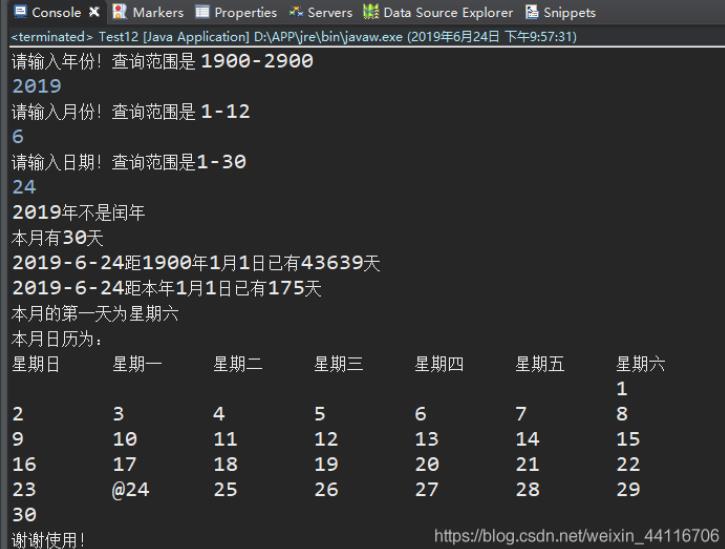java自定义日历
hellolxb 人气:0效果图:

源码:
package com.example;
import java.text.SimpleDateFormat;
import java.util.ArrayList;
import java.util.Calendar;
import java.util.Date;
import java.util.List;
import java.util.Locale;
import java.util.Scanner;
public class Test12 {
public static void main(String[] args) {
// TODO Auto-generated method stub
Scanner scanner = new Scanner(System.in);
System.out.println("请输入年份!查询范围是 1900-2900");
int year = scanner.nextInt();
System.out.println("请输入月份!查询范围是 1-12");
int month = scanner.nextInt();
System.out.println("请输入日期!查询范围是1-" + getMonth(month, year));
int day = scanner.nextInt();
Calendar calendar = Calendar.getInstance();
calendar.set(Calendar.YEAR, year);
calendar.set(Calendar.MONTH, month - 1);
calendar.set(Calendar.DAY_OF_MONTH, day);
System.out.println(year + "年" + (isRunYear(year) ? "是闰年" : "不是闰年"));
System.out.println("本月有" + getMonth(month, year) + "天");
int totalDays = 0;
for (int i = 1900; i < year; i++) {
totalDays += isRunYear(i) ? 366 : 365;
}
int nowDays = calendar.get(Calendar.DAY_OF_YEAR);
totalDays += nowDays;
System.out.println(year + "-" + month + "-" + day + "距1900年1月1日已有" + totalDays + "天");
System.out.println(year + "-" + month + "-" + day + "距本年1月1日已有" + nowDays + "天");
calendar.set(Calendar.DAY_OF_MONTH, 1);
System.out.println("本月的第一天为" + getFormatTime("EEEE", calendar.getTime()));
System.out.println("本月日历为:");
// 这里只是简单的输出字符串,假如在 Android Studio 的类似的开发平台中自定义日历的话,可以将泛型 String 换
// 成相应的 JavaBean 对象来存储数据和做标记,如标记是当月,是否被选中等。
List<String> list = new ArrayList<>();
// 得到本月一号的星期索引
// 索引从 1 开始,第一个为星期日,减 1 是为了与星期对齐,如星期一对应索引1,星期二对应索引二
int weekIndex = calendar.get(Calendar.DAY_OF_WEEK) - 1;
// 拿到上一个月的最后几天的天数
for (int i = 0; i < weekIndex; i++) {
list.add("");
}
int currentDays = getMonth(month, year);
// 拿到当月的天数
for (int i = 0; i < currentDays; i++) {
int days = i + 1;
if (days == day) {
list.add("@" + days);
} else {
list.add(days + "");
}
}
// 拿到下个月第一周的天数
// 先拿到本月最后一天的星期索引
calendar.set(Calendar.DAY_OF_MONTH, currentDays);
weekIndex = calendar.get(Calendar.DAY_OF_WEEK) - 1;
for (int i = 0; i < 6 - weekIndex; i++) {
list.add("");
}
String[] weeks = {"星期日", "星期一", "星期二", "星期三", "星期四", "星期五", "星期六"};
for (int i = 0; i < weeks.length; i++) {
System.out.print(getFormatString(weeks[i]));
}
System.out.println();
int i = 0;
for (String s : list) {
System.out.print(getFormatString(s));
if ((i + 1) % 7 == 0) {
System.out.println();
}
i++;
}
System.out.println("谢谢使用!");
}
public static String getFormatString(String s) {
// return String.format("%8s", s);
return s + "\t";
}
// 判断是否为闰年
public static boolean isRunYear(int y) {
return y % 4 == 0 && y % 100 != 0 || y % 400 == 0;
}
public static String getFormatTime(String p, Date t) {
return new SimpleDateFormat(p, Locale.CHINESE).format(t);
}
// 获取当月的天数
public static int getMonth(int m, int y) {
switch (m) {
case 2:
return isRunYear(y) ? 29 : 28;
case 4:
case 6:
case 9:
case 11:
return 30;
default:
return 31;
}
}
}加载全部内容